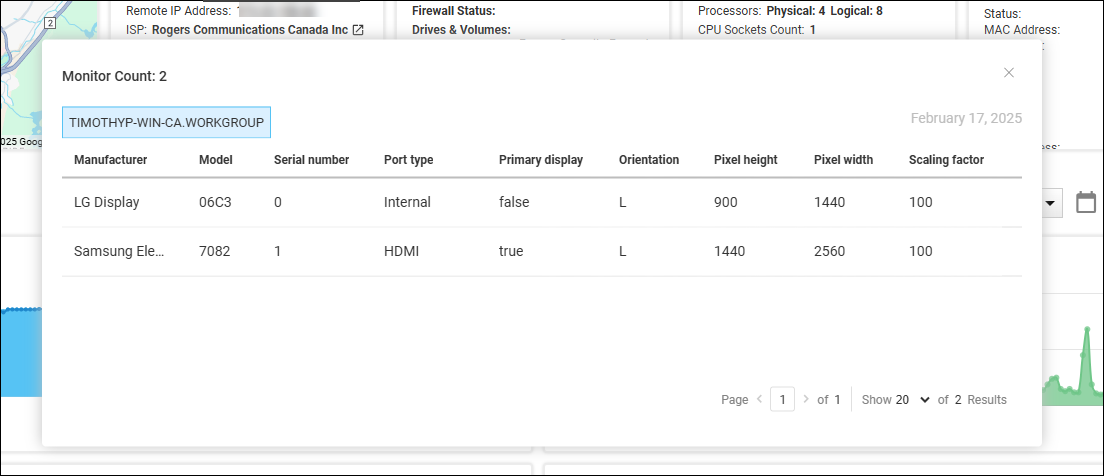Starting with Agent version 2.16, ControlUp collects information about peripherals connected to your devices. Currently, this only includes data about connected monitors (displays). You can use this data to ensure that a device's connected monitors are configured correctly. For example, you can receive an alert if the monitor layout or orientation changes on a device used to run digital signage.
When viewing the list of all devices on the Details tab, the Display Count column shows the number of connected monitors on each device.
When viewing details for a specific device, the Hardware section lists the number of connected monitors.

You can click on the number of monitors to see more information about the monitors.

Data collection frequency
- For Windows and macOS devices, monitor data is updated whenever a device's display configuration changes. Data is also updated every 24 hours even if no configuration changes were detected.
- For Linux devices, monitor data is updated every minute.
Collected data
The following monitor data is collected in the index builtin_peripherals. Some of this data might not be available if it's not provided from the connected monitor (for example, not all monitor manufacurers provide a product code).
| Column name | Description |
|---|---|
| display_audio | The supported audio codec formats if the display supports audio over HDMI. |
| display_device | The name of the display adapter (graphics card) outputting to the display. |
| display_dpms_active_off | If the display supports DPMS Active Off mode. |
| display_dpms_standby | If the monitor supports DPMS Standby Mode. |
| display_dpms_suspend | If the monitor support DPMS Suspend Mode. |
| display_index | The number assigned to the display by the device's OS. This is helpful to distinguish displays when multiple identical monitors are in use. |
| display_manufacturer | The name of the display's manufacturer. |
| display_mm_height | The height of the display in mm. This allows for DPI calculation. |
| display_mm_width | The width of the display in mm. This allows for DPI calculation. |
| display_model | The name of the display's model. |
| display_name | The display's name assigned by the device's OS. |
| display_orientation | The display's orientation (L = landscape, P = portrait). |
| display_pixel_bounding_height | The height (in pixels) of the device's virtual screen. |
| display_pixel_bounding_width | The width (in pixels) of the device's virtual screen. |
| display_pixel_height | The display's current height (in pixels). |
| display_pixel_height_max | The display's maximum supported height (in pixels). |
| display_pixel_origin_x | The distance along the x-axis (in pixels), from the top-left of the display to the multi-screen origin of the device's virtual screen. |
| display_pixel_origin_y | The distance along the y-axis (in pixels), from the top-left of the display to the multi-screen origin of the device's virtual screen. |
| display_pixel_width | The display's current width (in pixels). |
| display_pixel_width_max | The display's maximum supported width (in pixels). |
| display_port_type | The type of display port used to connect to the display, such as HDMI, DVI, DisplayPort, or Internal (for laptop displays). |
| display_primary | Whether the display is set as the primary display. |
| display_product_code | The display's product code. |
| display_rotation | The display's rotation in degrees. For example, if the display is set to landscaped (flipped), then display_rotation is 180. |
| display_scaling_factor | The display's scaling factor (percentage). Note that this isn't supported on some Linux devices. |
| display_serial_number | The display's serial number. |
| display_session | On multi-session systems where there are multiple displays assigned to multiple users, this indicates the display's session group. |
| display_update_id | A unique ID for each time a device sends updated display information. This is used to identify the set of displays currently connected to the device. |
| platform | The device's OS platform (1 = Windows, 2 = Mac, 3 = Linux). |
| type | The type of connected peripheral (for example, "Display"). |